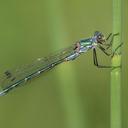United States and Canada
The head of the male, including the rear, is dark metallic green. The thorax is metallic green dorsally occasionally with a narrow pale yellow line along the mesopleural suture. The metepisternum is largely pale yellow. Dark spots may be present above and or below the metapleural carina. The abdomen is metallic green dorsally. The posterior portion of the thorax, abdominal segment 1, lateral portions of 2, ventrolateral portions of 7 and 8, and all of 9 and 10 become pruinose in older individ uals. The female is generally similar to the male but paler, with the metallic green areas less extensive. The ovipositor is long with valves extending to or beyond the posterior margin of the paraprocts. The posterolateral corner of the ovipositor basal plate is acutely angulate forming a distinctive tooth.
Size: Total length: 32-40 mm; abdomen: 24-30 mm; hindwing: 19-25 mm
Similar Species (south-central US): Emerald Spreadwing is smaller and stockier than most other spreadwing species. It is the only predominately metallic green species with dark marks posterior to the legs on the underside of the thorax. Both Elegant (L. inaequalis) and Swamp (L. vigilax) Spreadwings are substantially larger
Habitat: Temporary ponds and pools and permanent waters with sufficient shade
Natural History: Emerald Spreadwing is found in northern latitudes worldwide. This species is generally present early in the year, because it must complete its life cycle in the temporary pools in which it normally breeds before they dry up at the end of the summer. Eggs are laid in tandem in emergent plants high above the water line.
Distribution: Throughout Canada and northern United States extending south to California eastward to New Mexico; also Europe and Asia.
Source: Abbott, J.C. 2006-2010. OdonataCentral: An online resource for the distribution and identification of Odonata. Available at OdonataCentral.
Edited by Drew Weber (9/24/2015).
